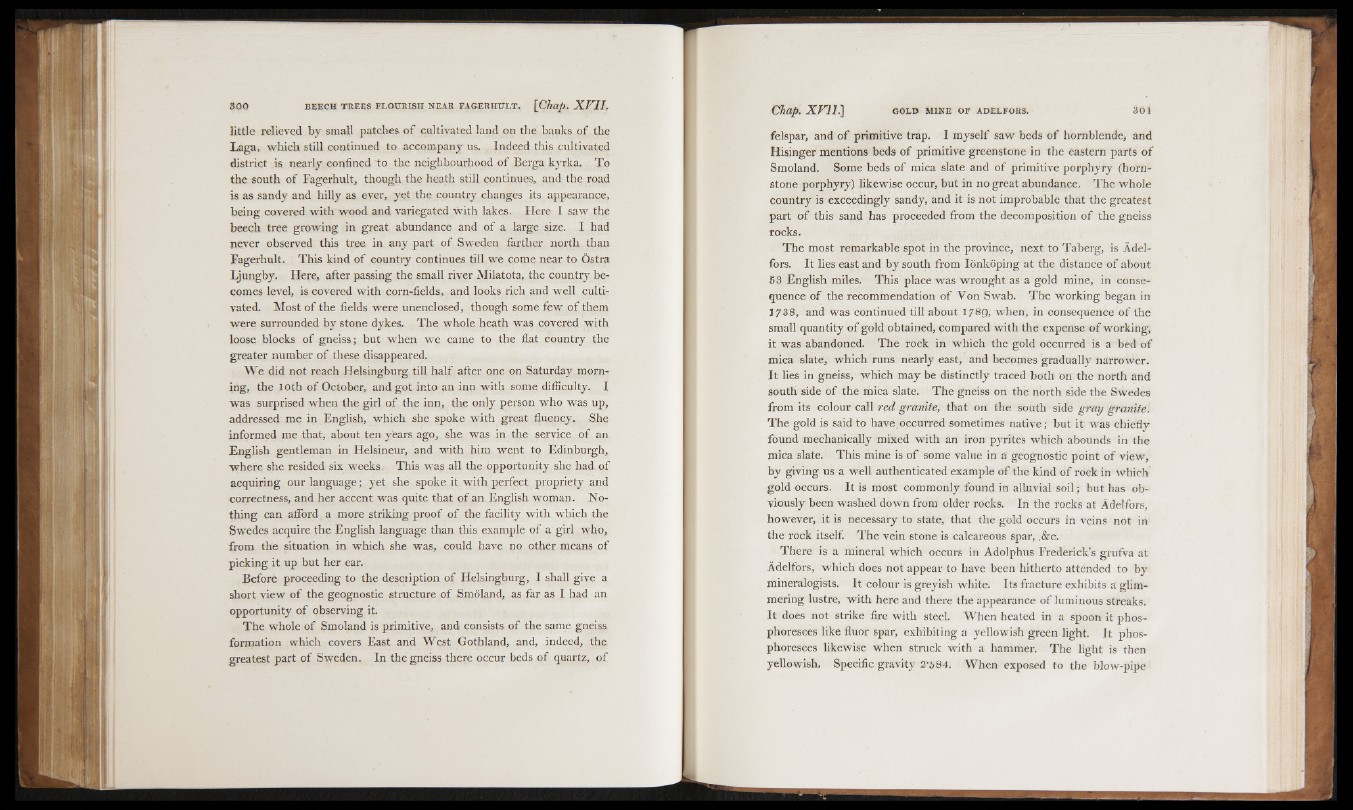
little relieved by small patches o f cultivated land on the banks of the
Eaga, which still continued to accompany us. Indeed this cultivated
district is nearly confined to the neighbourhood of Berga kyrka. To
the south of Fagerhult, though the heath still continues, and the road
is as sandy and hilly as ever, yet the country changes its appearance,
being covered with wood and variegated with lakes. Here I saw the
beech tree growing in great abundance and of a large size. I had
never observed this treu in any part of Sweden farther north than
Fagerhult. This kind of country continues till we come near to Ostra
Ljungby. Here, after passing the small river Milatota, the country becomes
level, is covered with corn-fields, and looks rich and well cultivated.
Most of the fields were unenclosed, though some few of them
were surrounded by stone dykes. The whole heath was covered with
loose blocks of gneiss; but when we came to the flat country the
greater number of these disappeared.
We did not reach Helsingburg till half after one on Saturday morning,
the loth o f October, and got into an inn with some difficulty. I
was surprised when the girl of the inn, the only person who was up,
addressed me in English, which she spoke with great fluency. She
informed me that, about ten years ago, she was in the service o f an
English gentleman in Helsineur, and with him went to Edinburgh,
where she resided six weeks. This was all the opportunity she had, of
acquiring our language; yet she spoke it with perfect propriety and
correctness, and her accent was quite that of an English woman. Nothing
can afford a more striking proof of the facility with which the
Swedes acquire the English language than this example of a girl who,
from the situation in which she was, could have no other means of
picking it up but her ear.
Before proceeding to the description of Helsingburg, I shall give a
short view of the geognostic structure of Smoland, as far as I had an
opportunity of observing it.
The whole of Smoland is primitive, and consists o f the same gneiss
formation which covers East and West Gothland, and, indeed, the
greatest part of Sweden. In the gneiss there occur beds of quartz, of
felspar, and of primitive trap. I myself saw beds o f hornblende, and
Hisinger mentions beds o f primitive greenstone in the eastern parts of
Smoland. Some beds of mica slate and of primitive porphyry (horn-
stone porphyry) likewise occur, but in no great abundance. The whole
country is exceedingly sandy, and it is not improbable that the greatest
part of this sand has proceeded from the decomposition o f the gneiss
rocks.
The most remarkable spot in the province, next to Taberg, is Adel-
fors. It lies east and by south from Ionkoping at the distance of about
53 English miles. This place was wrought as a gold mine, in consequence
o f the recommendation of Yon Swab. The working began in
1738, and was continued till about 1789, when, in consequence o f the
small quantity of gold obtained, compared with the expense o f working,
it was abandoned. The rock in which the gold occurred is a bed of
mica slate, which runs nearly east, and becomes gradually narrower.
It lies in gneiss, which may be distinctly traced both on the north and
south side of the mica slate. The gneiss on the north side the Swedes
from its colour call red granite, that on the south side gray granite.
The gold is said to have,occurred sometimes native; but it was chiefly
found mechanically mixed with an iron pyrites which abounds in the
mica slate. This mine is o f some value in a geognostic point o f view,
by giving us a well authenticated example o f the kind o f rock in which
gold occurs. It is most commonly found in alluvial soil; but has obviously
been washed down from older rocks. In the rocks at Adelfors,
however, it is necessary to state, that the gold occurs in veins not in
the rock itself. The vein stone is calcareous spar, ,&c.
There is a mineral which occurs in Adolphus Frederick’s grufva at
Adelfors, which does not appear to have been hitherto attended to by
mineralogists. It colour is greyish white. Its fracture exhibits a glimmering
lustre, with here and there the appearance of luminous streaks.
It does not strike fire with steel. When heated in a spoon it phosphoresces
like fluor spar, exhibiting a yellowish green light. It phosphoresces
likewise when struck with a hammer. The light is then
yellowish. Specific gravity 2'6 84. When exposed to the blow-pipe